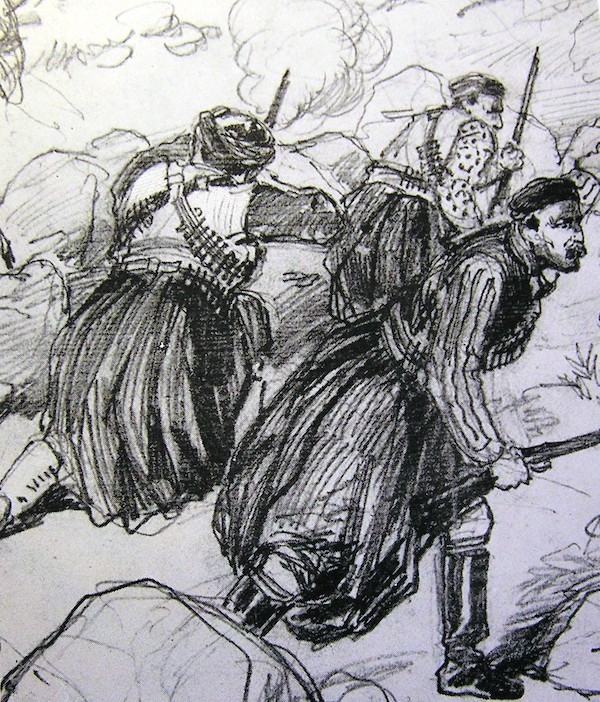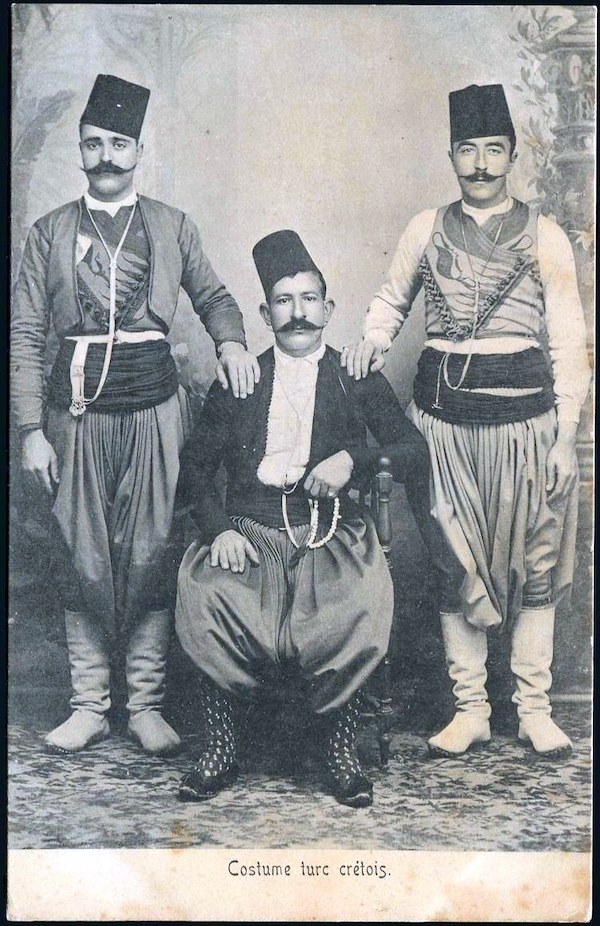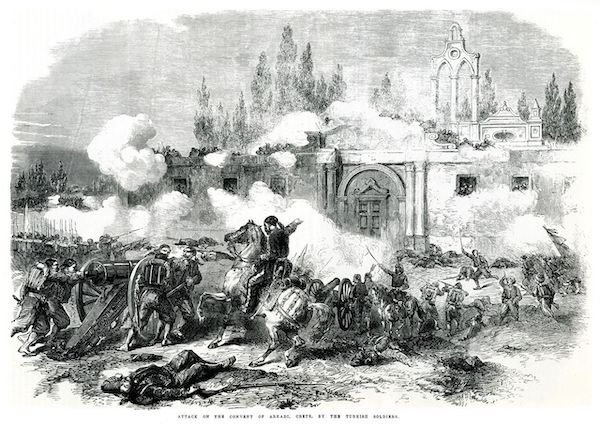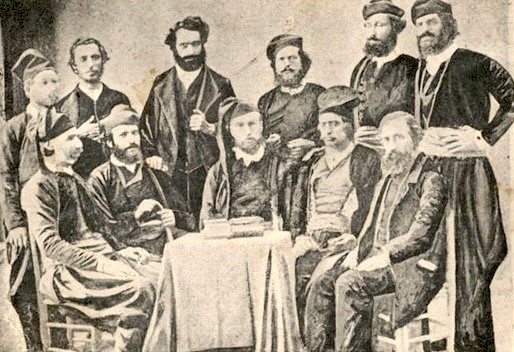Crete: Dress Rehearsal for Liberty
“We first find Skinner in March 1867 aboard the blockade-running, custom-built steamship the Arkadi, capable of 15 knots, faster than any ship the Turks had, en route from the island of Syros. With him are Colonel Sotfried of the Hungarian army and Monsieur Edmond Desmaze, described as a French sportsman from Algiers “seeking adventure.” The Arkadi anchors off the south-central coast of Crete. Boxes of ammunition, sacks of ship’s biscuit (rusks), and reams of paper to print the rebel news sheet ‘Moniteur’ are unloaded, and desperate refugees are taken aboard. It is a short stop—Turkish frigates are approaching.”—Michael House
Polemicist on History
By Michael House, FRGS

“Mark! where his carnage and his conquests cease!/He makes a solitude, and calls it—peace!”—Lord Byron
LONDON England—(Weekly Hubris)—1 December 2021—Much has been written about the international Philhellenes who flocked to Greece in the 1820s to aid the Greeks in throwing off the yoke of the Ottoman Turks. A 20th-century parallel would be the International Brigades of the 1930s who went to Spain to fight Franco and his fascists. We associate those interventions with two great writers—Lord Byron and George Orwell.
But little has been written about another group of brave Philhellenes who ran the Turkish naval blockade to join the insurrection on Crete in 1866-69. There are just a handful known by name: a Briton, several Frenchmen, a Hungarian colonel, an Italian soldier, and two American veterans of the Civil War (on the Union side, one need hardly add).
The only eyewitness account I have been able to trace was written by an English barrister, John Edwin Hilary Skinner. [See Author’s Note below.] In 1868, Richard Bentley, London, published Skinner’s Roughing It in Crete in 1867, after the author spent several months with the Cretan insurgents, and ran the Ottoman barricade. Skinner escaped to Kythira (Cerigo as it was then known) in order to write his book and raise public awareness
The Cretans believed that only if the European powers intervened could their uprising succeed. They received limited help from Greece and no significant help from the rest of Europe.
After many years of searching, I have finally managed to track down a first edition of Roughing It. It is vanishingly rare (no original editions for sale on the internet), but I can now sell my 21st-century reprint on eBay. I hate reading reprints.
Skinner’s life was not dull. For some curious reason, the career of a lawyer didn’t seem to appeal to him. In 1864, aged 25, he sought and obtained a commission from the “Daily News” to cover the conflict between Denmark and Prussia, embedded with the Danish army, resulting in his first book, The Tale of Danish Heroism.
A visit to America led to his 2-volume After the Storm. Then, Crete. In 1870, Skinner reported on the Franco-Prussian War while attached to the staff of the Prussian crown prince. To be first to report Sedan, the decisive battle of the war, he rode neck-and-neck back to London in competition with the celebrated William Howard Russell of the “Times,” only to find that he and Russell had been scooped by the correspondent of the Pall Mall Gazette.
He returned to law, and, in 1881, became assistant judicial commissioner on Cyprus. He ran for parliament in 1885 but was beaten in the South Paddington constituency by Lord Randolph Churchill, Winston’s father. He died in 1894 in Algeria, where he had gone for his health. A contemporary described him as “a dapper little man, overflowing with vivacity.”

Roughing It in Crete is not in the same class as Orwell’s Homage to Catalonia, but it is a well-written account of the life of insurgent bands trying to stay one jump ahead of the Turkish army, and of Cretan village life generally. (The rather sardonic reviewer of the Saturday Review wrote that it was “very readable.”)
We first find Skinner in March 1867 aboard the blockade-running, custom-built steamship the Arkadi, capable of 15 knots, faster than any ship the Turks had, en route from the island of Syros. With him are Colonel Sotfried of the Hungarian army and Monsieur Edmond Desmaze, described as a French sportsman from Algiers “seeking adventure.” The Arkadi anchors off the south-central coast of Crete. Boxes of ammunition, sacks of ship’s biscuit (rusks), and reams of paper to print the rebel news sheet “Moniteur” are unloaded, and desperate refugees are taken aboard. It is a short stop—Turkish frigates are approaching.
Skinner stepped into a stalemate. The insurrection had been active for about eight months, incited mainly by crippling taxation and interference in church affairs by the occupiers. The Turks had in the field around 20,000 regular troops and around 12,000 irregulars—mainly Cretan Turks. The rebels had bands operating in central and western Crete where they controlled country districts, numbering around 2,000, augmented by ad hoc volunteers when a particular area was threatened.
The Turks were primarily sitting tight in the citadels of Heraklion, Rethymnon, and Chania, waiting for reinforcements. The Cretans were carrying out sporadic guerrilla raids and spending much time looking for food in the mountain villages and waiting for the Arkadi to run the blockade and bring fresh supplies. It was a fight to the death—prisoners were rarely taken. Villages that did not submit to the Turks were burnt.
At Rodakino, Skinner joined a column of volunteers from the Mani, including veterans of the war of independence. The column set off for the Maniot HQ at Kerame, passing many refugees whose homes had been destroyed, carrying a few items saved from the wreck, with an occasional goat or donkey. They arrived at the Preveli monastery, in the foothills of Mount Ida, where they received a warm welcome. If foreigners from Europe arrived on horseback, could European frigates be far behind? Those hopes remained unrealized. The next destination was Melambes, a village threatened by the nearby Turkish fortress at Dibaki. A show of force discouraged any aggressive move against the village.

The force moved on to the Arkadi monastery, before November 1866 the largest and richest on Crete. Housing 600 refugees, it had been besieged by the Turks. As they broke through the defenses, someone who must have heard of the Alamo fired the magazine, causing a huge explosion that killed many Turks. Enraged, the besiegers embarked on an orgy of indiscriminate slaughter. Skinner saw “scores of bodies, unburied, half-buried, sun-dried and mangled.” The atrocity incited international fury, but no significant intervention.
The insurgent army then moved to the rich province of Mylopotamo, between Mount Ida and the north coast, where a Turkish incursion was expected. The optimistic Hungarian colonel wanted to turn the guerrilla force into a well-drilled and disciplined army but was gently told that this was not the Cretan way. In late April, the Turks began to move towards the pass of Tylissos, a vital route into Mylopotamo. The pass was held with ease, the Cretans pursuing the retreating Turks with cries of “Victory to the Cross.” Although Skinner’s state-of-the-art revolver was much admired by the Cretans, he never informed his readers whether he fired a shot in anger, or whether he was simply a spectator.
A problem for the victorious force was to keep it together after the battle. The men wanted to return home to their families. Superstition was another problem. Studying the blade-bones of yesterday’s lamb often led to dire predictions for the future.
Skinner and his colleague Desmaze contracted fever and were nursed at the home of Captain Basil (pseudonym) and his family at their home at Philoxenia (pseudonym). The captain’s teenage son Mathetes (pseudonym) was both a fighter and a poet, apologetic that he had only a few battered books in Greek with which to entertain the invalids. In the evening, the family cook would read aloud from the Arabian Nights and Mathetes would recite his bellicose verses.

Returning to HQ, Skinner met more foreign Philhellenes. Gustave Flourens (1838-18710) was an enthusiastic Frenchman, a propagandist for the Cretan cause. Jules Anemos (real name, Jules Ballot) was a teller of tall tales and a singer of songs on the march. Captain Leon Poinsot was the leader of a group of Philhellenes who had been operating in Sfakia during the winter. Achille Degrandi was an Italian army officer who seemed to enjoy warfare. He fought under Garibaldi in 1859, volunteered for the Federal army in the civil war, then fought the Austrians and was later killed at the battle of Lasithi, aged just 27. Skinner estimates that there were about a hundred foreign fighters or observers on Crete during the insurrection.
The insurgents were content to fight a long guerrilla campaign but were concerned about the safety of their families: the Turks were no respecters of women and children. A plan was formed for Skinner and others to take a caique to Santorini to get help in removing refugees from the island but the Turks landed a force on the north coast and the plan had to be abandoned. That force fought a battle with the rebels on 18 May, with day-long skirmishing and sniping. Skinner recalled hearing Cretan Greeks and Cretan Turks who knew each other shouting insults by name from behind their barricades. He reported: “This was not civilised warfare . . . but a stern struggle for life or death.” He recalled Turkish heads being collected as trophies. The battle ended in stalemate. The Turks could not break through, but the Greeks could not clear the plain of Turks.
Skinner headed by caique west along the south coast towards the province of Sfakia. At Hora Sfakia, he met two Americans, Rodokanaki, a Union navy veteran, and De Kay, late a Major in the Union army. They had with them a lethal machine of war, a torpedo linked to a battery by a long cable. A Cretan swimmer attached the torpedo to the anchor of a Turkish ship. When the ship weighed anchor, the cable broke and there was no explosion. Skinner’s caique passed the castle of Selino (modern Paleohora) and made its way up the west coast, heading for the islet of Cerigotto (Antikythira). There were aboard five Philhellenes, the crew and some refugee families. The boat made a slow passage up the west coast, dodging Turkish ships and making forays inland into the mountain villages to try to buy bread and supplies.
The caique finally left Crete and headed for the islet of Pontiko (Mouse Islet), where it hid for a day from a Turkish cruiser. Then on to Cerigotto and to Cerigo (Kythira), where Skinner caught the fortnightly steamer to Athens.
The war dragged on until 1869 when, under pressure from European powers, the Ottomans agreed to an armistice with modest concessions to the Cretans. But Crete remained an Ottoman possession until it achieved self-determination in 1898. The Western powers did not want the Ottoman Empire dismembered, since it comprised an important bulwark against Russian expansionism into the Mediterranean. Public figures such as Victor Hugo and Guiseppe Garibaldi campaigned in vain.
After leaving Crete, Skinner continued to promote the cause. On 11 March 1868, he delivered a public lecture in New York to raise funds for the provision of ambulances to ferry wounded Cretans from the battlefield. In letters to the “New York Times,” he asked Americans to raise “a few hundred dollars” to pay for an “ambulance mule train.”
By June 1868, Skinner was back on Crete. He wrote to the “New York Times” from a “little ruined church, seashore of Sfakia, Crete, June 16.” He reported that “the best blood of these wild, strong men is poured out on a mountain behind us in almost daily skirmishes to keep the foe at arm’s length.” He described a patient who had been treated for an eye injury and continued, “would that those in far away Western towns, who gave their dollars for the Cretan wounded, could see how much every ten cents will accomplish here.”
This man was not a fair-weather friend to Crete. He and his like didn’t move governments to intervene, but probably conditioned public opinion to the extent that when the next insurrection came, in 1896, governments had little choice but to support Cretan independence. The Ottoman massacres of Bulgarian civilians in the 1870s will also have played a major role in the international change of approach.
Author’s Note: I have since discovered others: Jules Ballot: Historoire de l’Insurrection Cretoise, Paris, 1868; Edmond Desmaze: Etudes et Souvenirs Helleniques, Lyon, 1878; Edmond Desmaze: Souvenirs d’un Philhellene: Gustave Flourans et l’Insurrection Cretoise de 1866-1868, Lyons, 1893.

